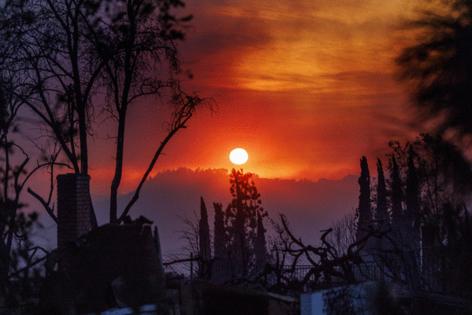Trump cuts to California National Weather Service leave 'critical' holes: 'It's unheard of'
Published in News & Features
LOS ANGELES — Some National Weather Service offices in California are among those hit hardest by meteorologist vacancies, according to new data from an employee union — heightening concerns as the state contends with another potentially devastating fire season and the ongoing threat of extreme weather.
The staffing shortages have forced some offices to outsource overnight operations to neighboring offices or reduce how often they issue forecast products that help keep decision-makers and first responders abreast of potentially hazardous weather conditions.
Trump administration officials have rejected the idea that recent cuts have imperiled the weather service's operations — even as those decisions have come under increased scrutiny following disastrous flooding in Texas that left at least 132 people dead. With fire season intensifying, California will be a key test case to determine the impact of the cuts.
Two of the nation's weather forecast offices with the worst meteorologist vacancy rates are in California. They are the Hanford office, which covers the San Joaquin Valley, including Fresno and Bakersfield; and the Sacramento office, which also covers Stockton, Modesto, Vallejo, Chico and Redding.
The offices are also responsible for the western Sierra Nevada — the Hanford office oversees forecasting for Yosemite, Kings Canyon and Sequoia national parks; the Sacramento office handles Lassen Volcanic National Park.
Each weather service office covering California is supposed to have anywhere from 13 to 16 meteorologists on staff.
But the Hanford office has just five meteorologists on staff, compared to eight vacancies, according to numbers supplied by the National Weather Service Employees Organization. That 62% vacancy rate is the worst in the nation, tying with Goodland, Kan., according to Tom Fahy, legislative director of the NWS Employees Organization.
"Hanford is one of the poorest-staffed offices in the country," Fahy said.
The Sacramento office has the second-worst vacancy rate in the nation, with just eight meteorologists on staff and eight vacancies, Fahy said. The Sacramento office has an allotment of 16 meteorologist positions because of the need to be a liaison with officials in the state capital, according to Alex Tardy, the former warning coordination meteorologist for the weather service's San Diego office.
The National Weather Service has seen its staff of 4,369 shrink to 3,757 through a combination of layoffs and buyouts, according to Fahy. That's a decline of 14%.
The staff reductions mean that the Hanford and Sacramento weather service offices no longer have enough staff to consistently operate on their own overnight and need to be covered by neighboring offices. At the Hanford office, for instance, calls that came in from around midnight to 6 a.m. were handled by the San Diego office this week.
"It's unheard of," said Tardy, who owns Weather Echo, a weather and climate information consulting business. "I worked for 32 years [with the National Weather Service], I worked a solo midnight shift a few times, and even that was frowned upon ... for safety reasons. So for an office to come out and say, 'We're not staffing the night shift from midnight to 6 a.m.,' that's a big deal."
The Sacramento office was operational overnight this week, aided by temporary staff assigned from another office.
The third-worst vacancy rates nationally were at the Cheyenne, Wyo., and Rapid City, S.D., offices, which each have seven meteorologists on staff and six vacancies.
Another area of concern is the two weather offices that serve Houston and Lake Charles, La. The office in Lake Charles has eight meteorologists now on staff but five vacancies. The Houston office, which covers a neighboring area, has nine meteorologists on staff but four vacancies.
The staff shortage "gets to a problem," given that the region of southeastern Texas "is a major hurricane entry point," Fahy said.
President Trump has sought to discount criticism that recent federal cuts to the National Weather Service played a role in the recent flooding disaster in Texas. "This was a thing that happened in seconds. ... They said once in a hundred years, they've never seen anything like this. ... It's just a horrible thing," he told reporters earlier this month.
The National Weather Service had warned about the potential for flash flooding days ahead of the Fourth of July disaster, and also issued a flood watch more than 12 hours before floodwaters surged into Camp Mystic, where at least 27 campers and counselors died.
Fahy said the National Weather Service's Austin/San Antonio office was adequately staffed the night of the disaster, with five forecasters working that shift, compared to the usual two or three. And the Austin/San Antonio office actually has a relatively low vacancy rate — 11 meteorologists are now on staff, with just two vacancies (although one vacancy is that of a warning coordination meteorologist).
But given the large staff vacancies at other weather forecast offices nationwide, other offices may strain to handle a huge weather emergency, he warned.
"If we had a massive rain event like we had in Kerr [County], Texas ... in a half-dozen cities around the United States right now, I'd shudder to think what would happen," Fahy said. "This draws attention that we have a lot of critical, critical staff shortages."
Erica Grow Cei, a spokesperson for the National Weather Service, said the agency is addressing the vacancies triggered by buyouts by temporarily reassigning other staff to cover key vacancies. The agency has also said it will hire for "a targeted number of permanent, mission-critical field positions ... under an exception to the department-wide hiring freeze," she said in a statement.
While weather offices can temporarily staff up for a shift during an emergency, it's not common for weather offices to be missing more than a few meteorologists for more than a few months, Tardy said.
"We've never had that situation. We're in uncharted territory," Tardy said.
This poses risks for California as it enters peak wildfire season, where the mix of bone-dry vegetation and ferocious winds can — and often does — spell disaster. Fall and winter bring their own mix of extreme weather whiplash, with some areas seeing extended perilous fire conditions just before the arrival of punishing rain, sudden landslides and deadly blizzards.
There are tremendous demands on the weather service during firestorms, for instance. If there's a wildfire in California, each weather office is required to have an incident meteorologist available for fires to head to the incident command post, which is an agreement with agencies such as the U.S. Forest Service and the California Department of Forestry and Fire Protection, Tardy said. That leaves the main weather forecast offices down another forecaster, Tardy said, possibly for weeks.
Understaffing could also lead to delays in issuing some key weather updates and alerts, such as a heat watch or a fire weather watch, which indicates when the risk of hazardous weather has increased significantly.
"Let's say you're working a midnight shift and you're in San Diego, but you're covering for Sacramento, right? I could see that shift saying, 'We're going to let the day shift handle it,'" Tardy said.
It's also not ideal to regularly rely on out-of-town meteorologists, as background knowledge of a region's peculiar weather patterns is helpful in making forecasts.
As the scope of the staff reductions became clear in April, the National Weather Service office in Sacramento said it was reducing staffing between 6 p.m. and 6 a.m., and that "the heavy lifting for the forecast ... will be done on the day shift." The office said there would be "less frequent posting and monitoring" of its accounts on X and Facebook — both of which have been a key resource for understanding statewide weather developments.
The Sacramento office began to issue its "area forecast discussion" only once a day instead of twice and shortened its format. The portion discussing fire weather forecast data is now updated only once a day, as well.
All these developments have the potential to degrade services that have become helpful to officials at all levels, Tardy said, such as live weather briefings where decision-makers and reporters can ask questions, as well as YouTube recordings and emails to officials and reporters.
In particular, briefings by Tardy, as well as the weather service's Oxnard office, became key sources of information during recent major weather events, such as forecasts warning of fire weather and severe winter storms.
Before he retired, Tardy was the San Diego weather service office's warning coordination meteorologist — a management job responsible for reaching out to first responders and emergency managers consistently and forming relationships that can become key during emergencies. Warning coordination meteorologist positions remain vacant in both the offices for San Diego, which also covers Orange County and the Inland Empire, and Oxnard, which is responsible for Los Angeles, Ventura, Santa Barbara and San Luis Obispo counties.
A warning coordination meteorologist is responsible for teaching emergency managers what specific types of weather alerts mean. If those positions remain vacant for, say, half a year, "you're really starting to lose your relationship with local officials," Tardy said.
Another concern with staffing shortages is that remaining employees will be overworked and burned out, and may opt to retire as job satisfaction diminishes, Tardy said. No new jobs have been posted for the weather service since a hiring freeze was ordered in late January, despite the authorization to hire a certain number of new employees, Tardy said.
"Overusing employees will lead to people finding other jobs or just plain quitting," Tardy said. Even if new jobs were posted today, Tardy said, it will take time to actually get any fresh hires up to speed.
With "each week, each month that goes by, there's more stress on these offices," he said.
©2025 Los Angeles Times. Visit at latimes.com. Distributed by Tribune Content Agency, LLC.







Comments